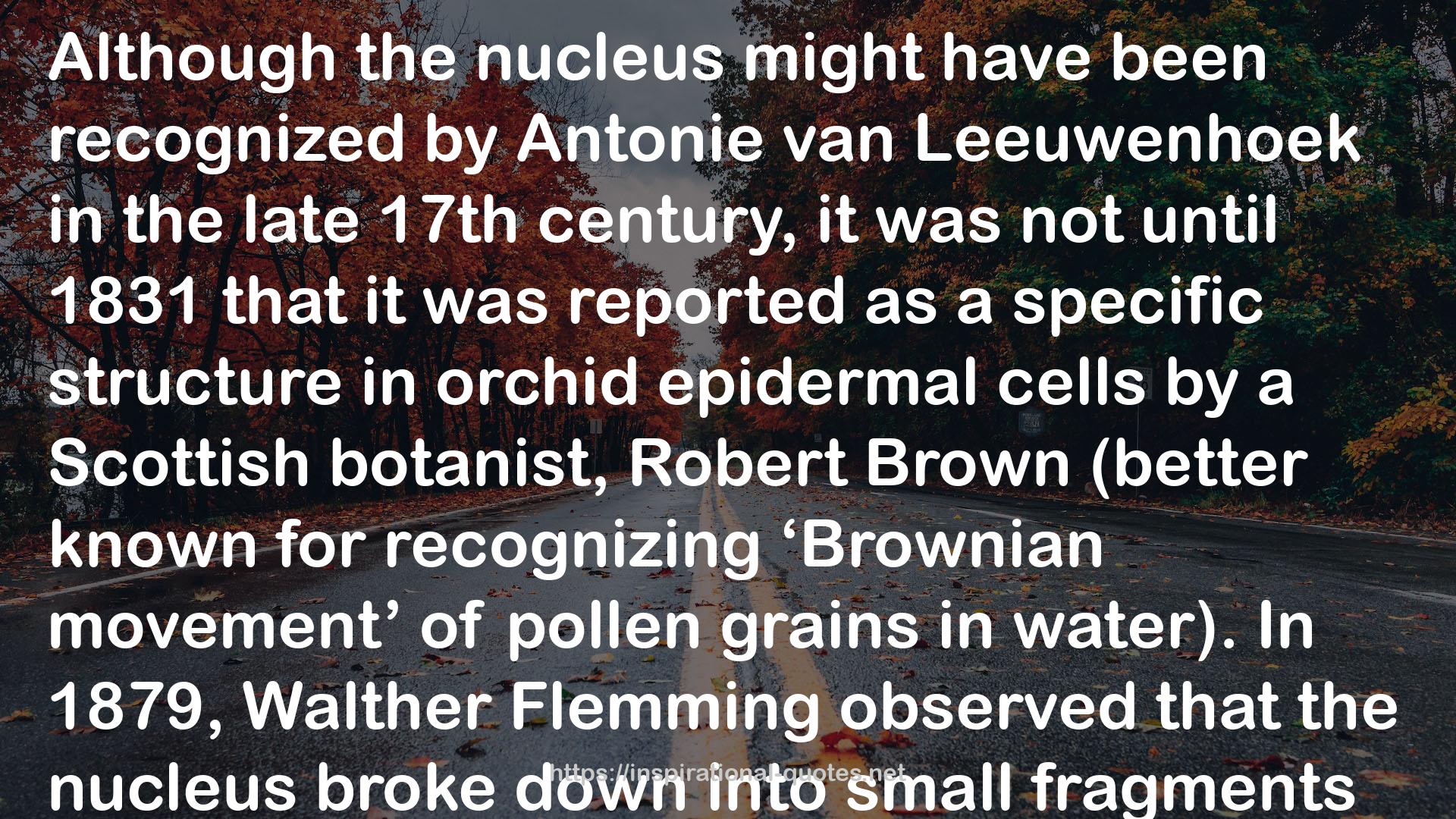The Cell: A Very Short Introduction QUOTES
1 " Although the nucleus might have been recognized by Antonie van Leeuwenhoek in the late 17th century, it was not until 1831 that it was reported as a specific structure in orchid epidermal cells by a Scottish botanist, Robert Brown (better known for recognizing ‘Brownian movement’ of pollen grains in water). In 1879, Walther Flemming observed that the nucleus broke down into small fragments at cell division, followed by re-formation of the fragments called chromosomes to make new nuclei in the daughter cells. It was not until 1902 that Walter Sutton and Theodor Boveri independently linked chromosomes directly to mammalian inheritance. Thomas Morgan’s work with fruit flies (Drosophila) at the start of the 20th century showed specific characters positioned along the length of the chromosomes, followed by the realization by Oswald Avery in 1944 that the genetic material was DNA. Some nine years later, James Watson and Francis Crick showed the structure of DNA to be a double helix, for which they shared the Nobel Prize in 1962 with Maurice Wilkins, whose laboratory had provided the evidence that led to the discovery. Rosalind Franklin, whose X-ray diffraction images of DNA from the Wilkins lab had been the key to DNA structure, died of cancer aged 37 in 1958, and Nobel Prizes are not awarded posthumously. Watson and Crick published the classic double helix model in 1953. The final piece in the jigsaw of DNA structure was produced by Watson with the realization that the pairing of the nucleotide bases, adenine with thymine and guanine with cytosine, not only provided the rungs holding the twisting ladder of DNA together, but also provided a code for accurate replication and a template for protein assembly. Crick continued to study and elucidate the base pairing required for coding proteins, and this led to the fundamental ‘dogma’ that ‘DNA makes RNA and RNA makes protein’. The discovery of DNA structure marked an enormous advance in biology, probably the most significant since Darwin’s publication of On the Origin of Species . "
3 " So how does a cell go about ending its own existence? The actual mechanism of ‘cell suicide’ depends upon mitochondria, termed the ‘angels of death’ by Nick Lane in his book, Power, Sex and Suicide: Mitochondria and the Meaning of Life . The first change occurs in the mitochondrial inner membrane, which becomes damaged by aberrant biochemical activity, leading to the formation of pores in the mitochondrial membrane (Figure 12b, d). At this point, the mitochondrion becomes committed to trigger apoptosis, and releases cytochrome c (a protein crucial to its normal function of energy production) which exits through the newly formed pores. This information came to light as a result of some neat experiments in which apoptotic mitochondria were introduced into perfectly healthy cells, resulting in apoptosis. The released cytochrome c binds to several other proteins in the cytoplasm to form a complex called the apoptosome which, in turn, activates a cascade of ‘executioner enzymes’ which not only kill the cell but cause fragmentation of the nucleus and cytoplasm into bite-size pieces ready to be phagocytosed by neighbouring cells. "
4 " The actual mechanics of cell division, according to Dick McIntosh at the University of Denver, require significantly more instructions than it takes to build a moon rocket or supercomputer. First of all, the cell needs to duplicate all of its molecules, that is DNA, RNA, proteins, lipids, etc. At the organelle level, several hundred mitochondria, large areas of ER, new Golgi bodies, cytoskeletal structures, and ribosomes by the million all need to be duplicated so that the daughter cells have enough resources to grow and, in turn, divide themselves. All these processes make up the ‘cell cycle’. Some cells will divide on a daily basis, others live for decades without dividing. The cell cycle is divided into phases, starting with interphase, the period between cell divisions (about 23 hours), and mitosis (M phase), the actual process of separating the original into two daughter cells (about 1 hour). Interphase is further split into three distinct periods: gap 1 (G1, 4–6 hours), a synthesis phase (S, 12 hours), and gap 2 (G2, 4–6 hours). Generally, cells continue to grow throughout interphase, but DNA replication is restricted to the S phase. At the end of G1 there is a checkpoint. If nutrient and energy levels are insufficient for DNA synthesis, the cell is diverted into a phase called G0. In 2001 Tim Hunt, Paul Nurse, and Leeland Hartwell received the Nobel Prize for their work in discovering how the cell cycle is controlled. Tim Hunt found a set of proteins called cyclins, which accumulate during specific stages of the cell cycle. Once the right level is reached, the cell is ‘allowed’ to progress to the next stage and the cyclins are destroyed. Cyclins then start to build up again, keeping a score of the progress at each point of the cycle, and only allowing progression to the next stage if the correct cyclin level has been reached. "
- Forbidden Mysteries of Faery Witchcraft
- Flawed (Flawed, #1)
- Of Beast and Beauty
- Unashamed
- The Mosquito Coast
- A Night at the Shanley Hotel
- Thrive Through Yoga: A 21-Day Journey to Ease Anxiety, Love Your Body and Feel More Alive
- The Courage to Teach, a Guide for Reflection and Renewal
- Kiss Me Someone: Stories
- I Owe You One

